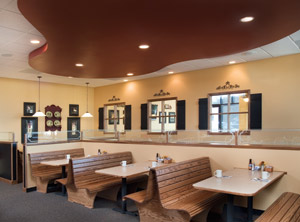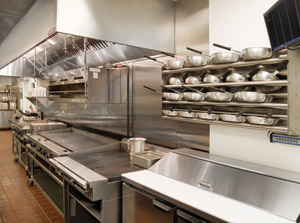A streamlined menu; a basic, off-the-shelf equipment package; and one daily shift covering two meal periods allow owners and franchisees to operate profitably and sustain consistent growth.
 A warm, friendly dining area contributes to the homelike ambiance in this Lakewood, Colo., restaurant. Friendly staff help guests feel welcome. In 2005, Bill Baumhauer and Don Lamb discovered an underserved breakfast/lunch niche in Colorado that they believed offered great growth potential. In addition, they were attracted to the limited hours of operation for a breakfast and lunch concept, which typically closes in midafternoon.
A warm, friendly dining area contributes to the homelike ambiance in this Lakewood, Colo., restaurant. Friendly staff help guests feel welcome. In 2005, Bill Baumhauer and Don Lamb discovered an underserved breakfast/lunch niche in Colorado that they believed offered great growth potential. In addition, they were attracted to the limited hours of operation for a breakfast and lunch concept, which typically closes in midafternoon.
Baumhauer and Lamb's attraction to this type of concept is understandable given their combined 50 years of restaurant experience. Baumhauer served as president, CEO and chairman of the board of directors for both Champps Entertainment Inc. and Fuddruckers Inc., and served as president and chief operating officer for Planet Hollywood Inc. Lamb served as senior vice president and chief operating officer for Champps Entertainment Inc., director of operations for Ruby Tuesday Inc., and area director for Houlihan's Restaurants Inc.
"We wanted to stay in Colorado after we left Champps," says Lamb. They formed E&I Holdings Inc. and in October 2005 acquired the rights to The Egg & I Restaurants from its owners, Rayno and Patty Seaser, who started the concept in 1987 in Fort Collins, Colo. The Seasers continue to own and operate two restaurants in Fort Collins and another in Loveland, Colo. Baumhauer and Lamb have expanded the concept from 17 restaurants in 2005 to 52 restaurants as of March 2012. Systemwide annual sales have increased from $17 million in 2005 to approximately $50 million today.
E&I Holdings owns and operates eight company stores, while franchisees operate the remaining 44 units. "We anticipate opening more corporate locations, which will help us support our franchise system as we expand nationally," Lamb says. "We also like the return on investment." The cost to build and equip a typical restaurant is approximately $125 per square foot, which provides a sales-to-investment ratio of approximately two to one. The Egg & I Restaurants has never had to close a restaurant in its 25-year history, Lamb says. Growth plans call for 25 to 30 additional restaurants to open annually for the next several years; they will serve a broad guest base that spans all age groups.
Employees work one shift per day, which covers the two meal periods. In addition, two managers work daily. "Because we're able to offer one shift to associates that covers two meal periods, we've been able to limit hourly annual turnover of our associates to less than 40 percent. This compares favorably to the national average turnover rate in casual dining of greater than 100 percent. Our associates often become friends with our guests, which also helps contribute to our low turnover rate," Lamb says.
By offering a breakfast and lunch menu that does not include appetizers and desserts, The Egg & I keeps the equipment package basic. "We buy 'plug-and-play' equipment off the rack rather than custom-built equipment, which helps contain costs," Lamb says. "We're obviously attempting to buy equipment that is durable and requires minimal maintenance."
 Meats and pancakes are prepared on the flattops. Staff use a 36-inch hot-top range to prepare fried and scrambled eggs, poached eggs for eggs Benedict, omelettes and all other egg dishes. Staff use another six-burner range for heating sauces and soups. A conventional oven beneath bakes most potatoes. An overhead salamander melts cheese. Photo taken in a Lakewood, Colo., restaurant.Solid kitchen management systems such as training, production, new product rollouts (about once a year) and a POS system also help reduce operating costs, Lamb says. Franchise restaurants are inspected by franchise consultants a minimum of three times a year to monitor adherence to systems.
Meats and pancakes are prepared on the flattops. Staff use a 36-inch hot-top range to prepare fried and scrambled eggs, poached eggs for eggs Benedict, omelettes and all other egg dishes. Staff use another six-burner range for heating sauces and soups. A conventional oven beneath bakes most potatoes. An overhead salamander melts cheese. Photo taken in a Lakewood, Colo., restaurant.Solid kitchen management systems such as training, production, new product rollouts (about once a year) and a POS system also help reduce operating costs, Lamb says. Franchise restaurants are inspected by franchise consultants a minimum of three times a year to monitor adherence to systems.
The Egg & I stores typically occupy 3,300 to 3,800 square feet. Preferable sites are endcap units of strip shopping centers, with an abundance of windows for maximum daylight and outside patio space. Most restaurants feature a French country-style décor. Signage that reads, "Mother always told you to eat a good breakfast!" hangs prominently in each location.
Kitchens consume about 33 percent of the restaurant's interior square footage. Food deliveries arrive at a loading dock or back door. Staff place deliveries into a combination walk-in cooler/freezer or onto dry-storage racks. Five countertop refrigerators hold products on the cookline so cooks have easy access to ingredients throughout the day. The beverage area features two countertop refrigerators.
At 5 a.m. production staff begins preparing items for service, using two prep tables. They prepare beverages by grinding coffee beans, brewing coffee, heating water for hot tea, and making ice tea and hot chocolate. They use blenders throughout the day to make smoothies to order. The Egg & I associates also use handheld blenders to make salad dressings, and food processors to make sauces and prepare ingredients for homemade soups.
Throughout the day, kitchen staff prepare menu items to order to keep food fresh. A cold rail holds ingredients adjacent to the cookline.
On the cookline, staff use one-half of a six-foot flattop griddle for cooking meats such as sausages, bacon, ham, and top sirloin to order throughout the day. Staff use the other half of the griddle to make pancakes and French toast. Another flat griddle is used for preparing ranch potatoes, a house specialty. A waffle iron makes this breakfast favorite.
Staff use a 36-inch hot-top range with large metal cast iron plates to prepare fried and scrambled eggs, poached eggs for eggs Benedict, omelettes and all other egg dishes. "We prepare eggs in pans to maintain their moisture and flavor," Lamb says. Oatmeal is also made on the hot-top range.
Staff use another six-burner range for heating sauces such as hollandaise used for eggs Benedict and making soups. A conventional oven beneath bakes most potato dishes. An overhead salamander melts cheese on Egg & I scrambles, skillets, eggs olé and omelettes.
Two conveyor toasters heat English muffins and bread purchased from local suppliers.
Sustainability factors into the return on investment. The Egg & I uses CFL lighting in the dining areas, motion sensors in the restrooms, high-efficiency hot water heaters and high-efficiency heating and cooling packages. The Dallas market will soon test heat pumps for the MUA conditioning.
On the chain's website, in the franchise section, the promise for success is clear: "Sprinkle in superior restaurant unit economics and a top-notch executive management team and the result is a turn-key restaurant ready to feed hungry friends and neighbors and deliver a unique business opportunity. Each day The Egg & I earns more accolades and fame for providing guests with a warm and friendly 'home away from home.' Proven recipes and delicious home-style cooking are why guests return and 'Best of . . .' awards dot the walls of our restaurants."
"Keeping the equipment package relatively simple and straightforward is another part of the success formula as we continue our aggressive expansion," Lamb says.
Key Players
- Chairman and CEO: Bill Baumhauer
- President and COO: Don Lamb
- Executive Chef: Outside Consultants
- Architect: Icon Architecture, Kansas City, Mo., and others
- Interior Design: Carla's A Classic Design, Centennial, Colo.
- Construction Consultants: M2 Development Services, Great Bend, Kan.
- Equipment Dealer: Hockenbergs, Kansas City, Mo.; Wasserstrom & Sons, Columbus, Ohio; Concept Services, Austin, Tex.
- Construction: Various regional contractors
Facts of Note
- Ownership: E&I Holdings Inc.
- Opened: 1987 by Rayno and Patty Seaser; acquired by E&I Holdings Inc. in October 2005
- Headquarters: Centennial, Colo.
- Units: 52 in 10 states
- Size: 3,400 to 3,800 square feet for endcap location in strip center; minimum of 70 parking spaces
- Seats: 130 to 150 inside with an average of 36 tables and an adjacent patio where available
- Average check: $10.50
- Total annual sales: $960,000 per unit/$50 million system wide
- Annual transactions: 91,430 average per restaurant per year
- No. of franchised restaurants: 44
- No. of company-owned restaurants: 8
- Franchise purchase cost: $45,000 franchise fee; minimum liquid assets/net worth of $150,000 to $500,000
- Hours: Weekdays, 6 a.m. to 2 p.m.; weekends, 7 a.m. to 2:30 p.m.
- Menu specialties: Eggs Benedict, omelettes, waffles, skillet dishes, whole-wheat pancakes, sandwiches, entrée salads, homemade soups and kids' menu
- Staff: One general manager; one kitchen manager; 20 to 30 hourly associates including hosts, servers, cooks, bussers and dishwashers
- Equipment investment: Approximately $450,000 for leasehold improvements and equipment
- Website: www.theeggandirestaurants.com



